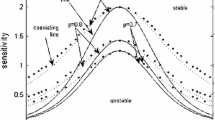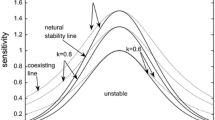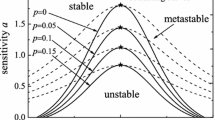Abstract
Car-following models are proposed to describe the jamming transition in traffic flow on a highway. In this paper, a new car-following model considering the driver’s forecast effect is investigated to describe the traffic jam. The nature of the model is studied using linear and nonlinear analysis method. A thermodynamic theory is formulated to describe the phase transition and critical phenomenon in traffic flow and the time-dependent Ginzburg–Landau (TDGL) equation is derived to describe the traffic flow near the critical point. It is also shown that the modified Korteweg-de Veris (mKdV) equation is derived to describe the traffic jam. The connection between the TDGL and the mKdV equations is given.
Similar content being viewed by others
References
Tang, T.Q., Li, C.Y., Huang, H.J., Shang, H.Y.: A new fundamental diagram theory with the individual difference of the drivers perception ability. Nonlinear Dyn. 67, 2255–2265 (2012)
Tang, T.Q., Li, C.Y., Wu, Y.H., Huang, H.J.: Impact of the honk effect on the stability of traffic flow. Phys. A 390, 3362–3368 (2011)
Tang, T.Q., Wu, Y.H., Caccetta, L., Huang, H.J.: A new car-following model with consideration of roadside memorial. Phys. Lett. A 375, 3845–3850 (2011)
Peng, G.H., Cai, X.H., Cao, B.F., Liu, C.Q.: A new lattice model of traffic flow with the consideration of the traffic interruption probability. Phys. A 391, 656–663 (2012)
Li, Z.P., Liu, F.Q., Sun, J.: A lattice traffic model with consideration of preceding mixture traffic information. Chin. Phys. B 20, 088901 (2011)
Li, Z.P., Gong, X.B., Liu, Y.C.: An improved car-following model for multiphase vehicular traffic flow and numerical tests. Commun. Theor. Phys. 46, 367–373 (2006)
Tian, H.H., Hu, H.D., Wei, Y.F., Xue, Y., Lu, W.Z.: Lattice hydrodynamic model with bidirectional pedestrian flow. Phys. A 388, 2895–2902 (2009)
Jiang, R., Wu, Q.S., Jia, B.: Intermittent unstable structures induced by incessant constant disturbances in the full velocity difference car-following model. Phys. D 237, 467–474 (2008)
Kerner, B.S., Konhauser, P.: Cluster effect in initially homogeneous traffic flow. Phys. Rev. E 48, 2335–2338 (1993)
Newell, G.F.: Nonlinear effects in the dynamics of car-following. Oper. Res. 9, 209–229 (1961)
Pipes, L.A.: An operational analysis of traffic dynamics. J. Appl. Phys. 24, 274–281 (1953)
Bando, M., Hasebe, K., Nakayama, A., Shibata, A., Sugiyama, Y.: Dynamical model of traffic congestion and numerical simulation. Phys. Rev. E 51, 1035–1042 (1995)
Helbing, D., Tilch, B.: Generalized force model of traffic dynamics. Phys. Rev. E 58, 133–138 (1998)
Jiang, R., Wu, Q.S., Zhu, Z.J.: Full velocity difference model for a car-following theory. Phys. Rev. E 64, 017101 (2001)
Ge, H.X., Cheng, R.J., Li, Z.P.: Two velocity difference model for a car following theory. Phys. A 387, 5239–5245 (2008)
Nagatani, T.: Jamming transition in the lattice models of traffic. Phys. Rev. E 59, 4857–4864 (1999)
Nagatani, T.: Thermodynamic theory for the jamming transition in traffic flow. Phys. Rev. E 58, 4271–4276 (1998)
Nagatani, T.: TDGL and MKDV equations for jamming transiton in the lattice models of traffic. Phys. A 264, 581–592 (1999)
Ge, H.X., Cheng, R.J., Lo, S.M.: Time-dependent Ginzburg–Landau equation for lattice hydrodynamic model describing pedestrian flow. Chin. Phys. B 22, 070507 (2013)
Tang, T.Q., Huang, H.J., Shang, H.Y.: A new macro model for traffic flow with the consideration of the driver’s forecast effect. Phys. Lett. A 374, 1668–1672 (2010)
Tang, T.Q., Li, C.Y., Huang, H.J.: A new car-following model with the consideration of the driver’s forecast effect. Phys. Lett. A 374, 3951–3956 (2012)
Peng, G.H., Cai, X.H., Liu, C.Q., Tuo, M.X.: A new lattice model of traffic flow with the anticipation effect of potential lane changing. Phys. Lett. A 376, 447–451 (2012)
Kang, Y.R., Sun, D.H.: Lattice hydrodynamic traffic flow model with explicit driver’s physical delay. Nonlinear Dyn. 71, 531–537 (2013)
Acknowledgments
Project supported by the National Natural Science Foundation of China (Grant Nos. 11372166, 11372147 and 61074142), the Natural Science Foundation of ZheJiang Province (Grant No.Y13A010029) and K.C.Wong Magna Fund in Ningbo University.
Author information
Authors and Affiliations
Corresponding author
Rights and permissions
About this article
Cite this article
Lv, F., Zhu, HB. & Ge, HX. TDGL and mKdV equations for car-following model considering driver’s anticipation. Nonlinear Dyn 77, 1245–1250 (2014). https://doi.org/10.1007/s11071-014-1374-5
Received:
Accepted:
Published:
Issue Date:
DOI: https://doi.org/10.1007/s11071-014-1374-5




